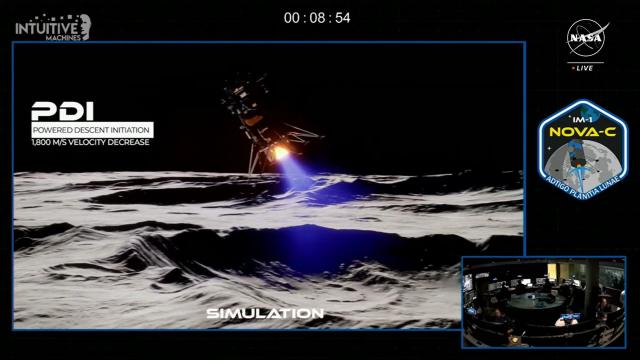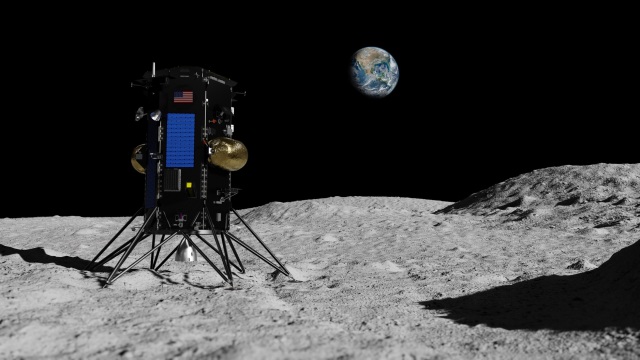On February 23, the Nova-C probe of the Texas company Intuitive Machines landed relatively successfully 300 kilometers from the South Pole of the Earth's satellite after eight days of flight. However, an emergency situation occurred: the device, which is also called the Odyssey, sat down on a slope and collapsed its upper part on a rock; its antennas are in a position that makes it difficult to transmit data, but the solar panels and part of the payload are in working order.
More than 12 hours after the moon landing, representatives of NASA and Intuitive Machines gave a press conference at which they talked about the details of the not quite successful landing. Nova-C was saved by one of the instruments placed on board as a payload — a navigation Doppler lidar from NASA, which received data on the height of the device and the speed of its descent, while the standard landing radars failed. The main task of the project — to demonstrate a soft landing with great accuracy — was completed as a result.
However, due to the high horizontal speed during landing, the probe could not maintain its vertical position, as originally reported, and tipped over, resting against a nearby rock.
Photos from the Moon's surface will have to wait a little longer, perhaps they will not be able to be obtained at all. The Odyssey antennas are obviously located on the side of the device, which it collapsed on a rock, which makes it extremely difficult to transmit data to Earth. At the same time, the solar panels work, as well as part of the payload. The detachable EagleCam camera, which was supposed to be shot off during the descent to the surface of the Moon, had to be turned off. However, according to the project team, it is in working condition and will be separated from Nova-C later to remove the device on the surface of the Moon. At best, the probe will be able to work on the surface of the Moon for about 10 days, before the onset of lunar night.
This was the first landing of an American spacecraft on the surface of the Moon in more than half a century, as well as the first time it was carried out by a private company. The Nova-C probe landed on February 23 at 02:24 Moscow time in the area of the Malapert A crater, which is located 300 kilometers from the South Pole of the Moon, the company that developed it said immediately after the estimated landing time. Initially, it was assumed that the device would land at 1:49 Moscow time, but then the landing time was changed twice.
Despite the claimed successful lunar landing, it took the Intuitive Machines team about 10-15 minutes to establish communication with the probe.
On the eve of the device, after a 408-second turn-on of the engine running on methane and liquid oxygen, it successfully entered a circumlunar orbit with a height of 92 kilometers. At that time, it had already traveled over one million kilometers since its launch on February 15.
Nova-C was launched on February 15 using SpaceX's Falcon 9 launch vehicle, which launched from the LC-39A site of the Kennedy Space Center at Cape Canaveral in Florida. 48 minutes after launch, the spacecraft separated from the second stage and immediately switched to a flight path to the Moon, without entering Earth orbit. This was the first launch of a lunar expedition from the LC-39A site in 52 years (the last time Apollo 17 was launched from here was in 1972).
Despite the successful launch, the spacecraft encountered difficulties during its flight to the moon. The company's mission control center in Houston found that the Nova-C navigation system rejected data from the star sensor, an instrument that determines the orientation of the device in space. However, the specialists managed to send a correction to the probe in time, and Nova-C successfully accepted the new data.
On February 16, the probe conducted the first of three maneuvers to correct its trajectory using a main engine that worked for 21 seconds at full thrust. This allowed the device to reach a speed of 21 m/s. The second maneuver was performed on February 18, and the third shortly before the probe entered orbit around the Moon, when Nova—C was 68 thousand kilometers from the Earth's satellite.
 |
| Nova-C. |
| Source: prt scr youtube.com | NASA |
NASA research instruments are on board the Odyssey: an array of LRA laser retroreflectors, an NDL Doppler lidar, four SCALPSS stereo cameras and others. In addition, a cubesat was supposed to be launched from the probe into the Moon's orbit, designed to check the connection between the Moon and the Earth, which is most likely impossible after the spacecraft capsizes. For the delivery of all this, NASA paid Intuitive Machines about $118 million.
Private payloads include a detachable Eaglecam camera, two ILO-X cameras, the DRaaS experiment, and heat-resistant material from Columbia. During the flight to the Moon, the spacecraft managed to transmit several images to Earth: they captured, in particular, the near side of the Earth's satellite and the satellite crater Belkovich K. At the press conference, a representative of Intuitive Machines also showed a photo of Nova-C over the Schomberger crater, about 200 km from the intended landing site, when the device was at an altitude of 10 km above the surface of the Moon.
Karolina Zulkarnayeva

